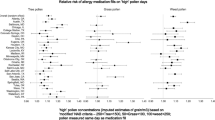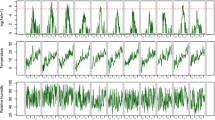Abstract
Google Trends (GT) describes the variation of the relevant interest of internet searches toward medical conditions and related symptoms. Allergic rhinitis symptom levels result from the intensity of exposure to aeroallergens in combination with relevant medication use. We analyze data from Germany to examine the relationship between hay fever-related Google search terms, symptom levels, medication use, and pollen count levels. For doing so, we also employ the new definitions on pollen season and peak pollen period start and end as proposed by the European Academy of Allergy and Clinical Immunology in a recently published position paper. We extract GT data for a number of search terms related to allergic rhinitis for Germany. We use total nasal symptom and mediation scores as reported by patients via a patient hay fever diary in the Berlin and Brandenburg areas in Germany for 3 years (2014–2016), accompanied by pollen data. Then a Pearson and Spearman correlation analysis is performed between symptom data and GT data. A graphical analysis is conducted, and the identification of pollen season and peak pollen periods is done based on the EAACI criteria. The analysis reveals that GT data are highly correlated with symptom levels and follow peak pollen period start–end, concerning grass and birch pollen-induced allergic rhinitis symptoms. GT data can be used as a proxy for the identification of the onset and variation of nasal symptom and medication score for allergic rhinitis sufferers.
Similar content being viewed by others
References
Bastl, K., Kmenta, M., Jäger, S., Bergmann, K. C., & Berger, U. (2014). Development of a symptom load index: Enabling temporal and regional pollen season comparisons and pointing out the need for personalized pollen information. Aerobiologia, 30(3), 269–280.
Berger, U., Jäger, S., & Bergmann, K. C. (2011). PHD, the electronic patient’s hayfever diary. European Respiratory Journal, 38(Suppl 55), 3213.
Bousquet, J., Agache, I., Anto, J. M., Bergmann, K. C., Bachert, C., Annesi-Maesano, I., et al. (2017). Google Trends terms reporting rhinitis and related topics differ in European countries. Allergy, 72(8), 1261–1266.
Campbell, M. J., Machin, D., & Walters, S. J. (2007). Medical statistics: A textbook for the health sciences (4th ed.). Chichester: Wiley.
Gibbons, J. D., & Chakraborti, S. (2011). Nonparametric statistical inference. Florida: Chapman & Hall.
Kang, M. G., Song, W. J., Choi, S., Kim, H., Ha, H., Kim, S. H., et al. (2015). Google unveils a glimpse of allergic rhinitis in the real world. Allergy, 70(1), 124–128.
Karatzas, K., Katsifarakis, N., Riga, M., Werchan, B., Werchan, M., Berger, U., et al. (2018). New European Academy of Allergy and Clinical Immunology definition on pollen season mirrors symptom load for grass and birch pollen‐induced allergic rhinitis. Allergy, 73, 851–1859. https://doi.org/10.1111/all.13487.
Karatzas, K., Voukantsis, D., Jäger, S., Berger, U., Smith, M., Brandt, O., et al. (2014). The patient’s hay-fever diary: Three-years of results from Germany. Aerobiologia, 30(1), 1–11.
König, V., & Mösges, R. (2014). A model for the determination of pollen count using Google search queries for patients suffering from allergic rhinitis. Journal of Allergy (Cairo), 2014, 381983.
Ling, R., & Lee, J. (2016). Disease monitoring and health campaign evaluation using Google Search activities for HIV and AIDS, stroke, colorectal cancer, and marijuana use in Canada: A retrospective observational study. JMIR Public Health and Surveillance, 2(2), e156.
Mösges, R., Adrian, M., el Hassan, E., & König, V. (2011). What Google® knows about the pollen season. Allergy, 66(5), 707–708.
Oteros, J., García-Mozo, H., Viuf Ørby, P., & Galán, C. (2015). Google Trends, useful tool in airborne pollen detection. Anales de la Facultad de Medicina, 76(3), 265–268.
Pfaar, O., Bastl, K., Berger, U., Buters, J., Calderon, M. A., Clot, B., et al. (2017). Defining pollen exposure times for clinical trials of allergen immunotherapy for pollen-induced rhinoconjunctivitis—An EAACI position paper. Allergy, 72(5), 713–722.
Riga, M., Stocker, M., Rönkkö, M., Karatzas, K., & Kolehmainen, M. (2015). Air quality information extraction from Twitter with the use of Self-Organizing Maps. Journal of Environmental Informatics, 26(1), 27–40.
Tkachenko, N., Chotvijit, S., Gupta, N., Bradley, E., Gilks, C., Guo, W., et al. (2017). Google Trends can improve surveillance of Type 2 diabetes. Scientific Reports, 7, 4993.
Wikipedia. (2018). Google Trends. https://en.wikipedia.org/wiki/Google_Trends. Accessed 1 June 2018.
Author information
Authors and Affiliations
Contributions
KCB and KK conceived and initiated the study, LP prepared the Google Trends data, BW and MW prepared the pollen and the symptom data, KK designed the study framework, KK, NK, and MR made the computations and graphical analysis, KK drafted the manuscript, UB provided with expert support, and KCB provided with expert advice and support.
Corresponding author
Ethics declarations
Conflict of interest
The authors declare that they have no competing interests
Rights and permissions
About this article
Cite this article
Karatzas, K., Papamanolis, L., Katsifarakis, N. et al. Google Trends reflect allergic rhinitis symptoms related to birch and grass pollen seasons. Aerobiologia 34, 437–444 (2018). https://doi.org/10.1007/s10453-018-9536-4
Received:
Accepted:
Published:
Issue Date:
DOI: https://doi.org/10.1007/s10453-018-9536-4








